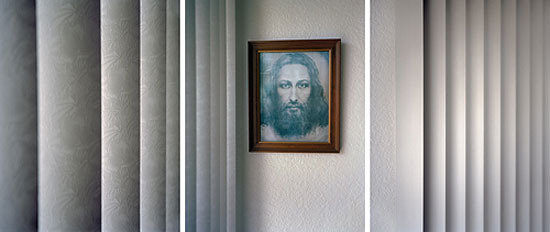Remember Then
dal 2/2/2011 al 14/3/2011
Segnalato da
Jesse Avina
Carrick Bell
Wafaa Bilal
Kevin Buzzell
Helen Maurene Cooper
Jill Frank
Eiko Grimberg
Sharon Harper
Julia Hechtman
David Hilliard
Chelsea Knight
John Merrill
Daniel Poller
Grant W. Ray
Arne Reimer
Irina Rozovsky
Michael Ruglio-Misurell
Jayanti Seiler
Kurt von Stetten
and Nicole White
Regina Mamou
Scott Patrick Wiener
2/2/2011
Remember Then
Concourse Gallery - Harvard University, Cambridge
The exhibition is based on a simple premise that photographs are used as tools by our culture to recall the past. The artists in Remember Then set out to interrogate this proposition, and memories are used as source material for recreating images in the present, systematically and through various methodologies. How a viewer understands and receives this new memory is the catalyst for each image.

Curated by Regina Mamou and Scott Patrick Wiener
Participating Artists: Jesse Avina, Carrick Bell, Wafaa Bilal, Kevin Buzzell, Helen Maurene Cooper, Jill Frank, Eiko Grimberg, Sharon Harper, Julia Hechtman, David Hilliard, Chelsea Knight, John Merrill, Daniel Poller, Grant W. Ray, Arne Reimer, Irina Rozovsky, Michael Ruglio-Misurell, Jayanti Seiler, Kurt von Stetten, and Nicole White.
Remember Then: An Exhibition on the Photography of Memory is based on a simple premise that photographs are used as tools by our culture to recall the past. The artists in Remember Then set out to interrogate this proposition, and memories are used as source material for recreating images in the present, systematically and through various methodologies. How a viewer understands and receives this new memory is the catalyst for each image.
Memories are fallible because they are subject to an arbitrary jumble of personal significance, defying neat, historicized packages. However, methodologies can serve to occupy this space, and make meaning and order out of randomness. Many of the images in Remember Then serve as an example of this concept; the original memory is inadequately represented by a single image, but rather by a series of images, which serve to organize personal history, or archive memories based on internal significance.
Nevertheless, memory, and ultimately history, cannot be accurately reduced to a system of representation. Images, whether singular or multiple, provide significant points of reference that function like springboards. These mnemonic devices send a viewer backward, through a spiraling, cognitive space rich with subjective associations. Cognition becomes a universe where surrounding constellations may be accessed or ignored depending on one's needs or desires.
In the essay "Photography," Siegfried Kracauer describes the "ur-image" as memory images that result from direct human contact (Thomas Y. Levin, ed., trans., The Mass Ornament: Weimar Essays, 50). The "ur-image" retains a situational context, the retrieval of which necessitates recollection. A photograph cannot wholly capture this; the machinery focuses and captures only that which is chosen, subsequently relegating the event to a relational object. Pictures are the remaining likenesses, where "the ur-image has long since decayed" and "a person's history is buried as if under a layer of snow" (ibid., 48, 51).
Where does this situation leave the artist who uses photography precisely as an indicator of memory? To paraphrase Walter Benjamin in his essay "The Task of the Translator," no translation is possible if it strives for likeness to the original, for in its afterlife the original undergoes a change (Hannah Arendt, ed., Harry Zohn, trans., Illuminations: Essays and Reflections, 73). In this sense the photographic image is translated from its original form (the event being recorded) into an abstraction–a physical object that stands in the present–making specific reference to the circumstances of psychology from which they are born.
Photographic documentation thus stands as inadequate representation of human memory (individual and collective) contextualized by its socio-historic circumstances, which has implications for both production and reception. It is in the space of the image's inadequacy that the artists in the exhibition exemplify the politics of maintaining and exerting control over how memories can be reconstituted. Remember Then is not a call to remember a particular past, but an invitation to experience the changing conditions of our relationship to memory.
For additional information, please contact:
Regina Mamou, rmamou@gmail.com
Scott Patrick Wiener, scott.wiener1@gmail.com
Image: David Hilliard, Jesus in the Guest Room, Digital C-Print, 24 x 60 inches (Triptych), 2009
Opening Reception: Thursday, February 3, 2011, from 6–9pm.
Concourse Gallery
Center for Government and International Studies
Harvard University
1730 Cambridge Street, Cambridge, Massachusetts 02138
Hours: Monday–Friday, 7am–7pm



